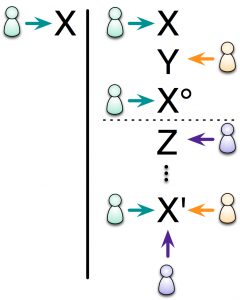In preparation for our webinar with Citrix and the eLearning Guild, I’ve been thinking through the benefits of learning socially, specifically for formal learning. I’ve articulated before that I think it’s about processing, but I like to try to capture my thinking in a graphic, and hadn’t done so before. I did so now, and thought I’d share it.
 In this representation, an individual, in creating an output such as a blogpost or a response to a discussion question in a forum, or a response to an assignment, has to do some reasonably robust processing. Typically, by going from thought to an external representation, you find that you’ve got some gaps and have to fix them. Eventually, however, you come up with what you think is right. And you submit it, say, in formal learning, and eventually may get feedback from an instructor.
In this representation, an individual, in creating an output such as a blogpost or a response to a discussion question in a forum, or a response to an assignment, has to do some reasonably robust processing. Typically, by going from thought to an external representation, you find that you’ve got some gaps and have to fix them. Eventually, however, you come up with what you think is right. And you submit it, say, in formal learning, and eventually may get feedback from an instructor.
But consider where you share that representation, and someone else comments in a way that indicates a different perspective, say in the discussion forum or to your post; then you may have to rethink what you said in light of that alternate viewpoint. You have to do some additional processing.
Then go further: suppose that a team has to come with a convergent answer. Then you might get a number of cycles of expressed viewpoints, additional processing (by all members of the team), sufficient to come to an agreed-upon view. Then you have lots of alternate ideas, and re-processing going on. That, to me, is the power of social learning. In that process of negotiation, you are thinking again and again about a topic, let alone with additional input and viewpoints.
Now, there are lots of nuances that have to go into this, such as designing an assignment that has enough ambiguity or challenge to have sufficient variety in viewpoint, but not so much as to lead to an inability to eventually agree.
This, of course, also is what happens in informal learning, if we end up discussing a problem to solve, or even just blog our thoughts and get comments. As Jay Cross says, the most powerful learning technology is conversation. It’s even better, however, if there’s a resulting artifact, a representation that captures the understanding, as the externality reduces the opportunity for misinterpretation.
So, does this representation make sense to you?
